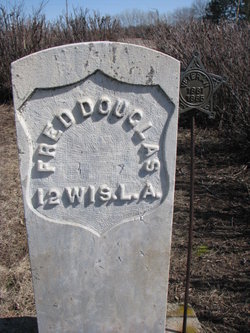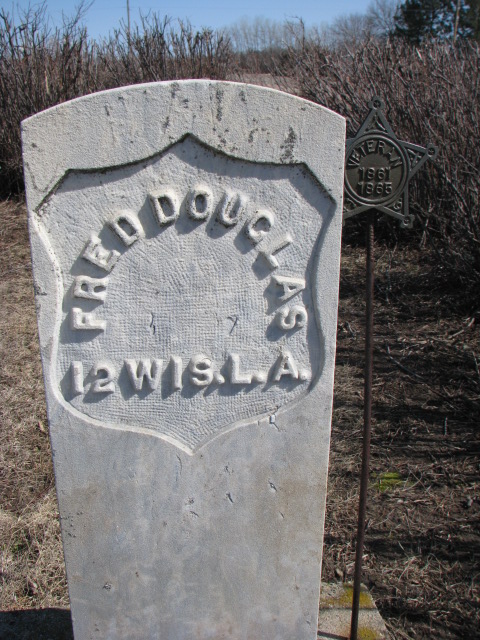MINNESOTA STATE MILITIA
12TH WISCONSIN LIGHT ARTILLERY
While Fred Douglas didn't see much action, if any, against rebels during the Civil War, he experienced great atrocities as a member of the Minnesota Militia that helped rescue settlers near New Ulm following the Sioux Indian uprising in 1862.
Douglas was born at Wales, Erie Co, NY on Jan 22, 1831. The Douglas' moved to Wisconsin in early 1850. On Christmas Day in 1850, Douglas married Myra Jane White at the family home in Green Lake, Wisconsin. Douglas was a cousin to the famous orator and Illinois Politician, Stephen Douglas. Stephen Douglas is now most remembered for his great debates with another Illinois politician, Abraham Lincoln, during the U.S. Congressional race in 1858.
In the spring of 1851, Fred and Myra moved to land on the edge of Menominee Indian claims. They lived in a house made of hewn logs. In 1862, they moved to Minnesota and in June, Douglas enlisted in the Minnesota state militia on frontier scout duty.
His militia unit, along with Federal soldiers, helped rescue settlers who survived the Sioux uprising near New Ulm in August of that year. Many settlers were massacred during the four day battles that ensued. Douglas witnessed many horrible scenes during his work in the New Ulm area that summer. Thirty-eight Sioux Indians were executed in Mankato in December 1862 because of their part in the uprising and massacre.
Douglas moved his family back to Wisconsin in 1864. He enlisted in the 12th Wisconsin Light Artillery at age 32 in Janesville. He was mustered in on February 5, 1864 at Camp Randall. He listed his occupation as a farmer. Douglas' description states that he was five foot eight inches tall with blue eyes and light hair and complexion.
From February until June 1864, Douglas and his unit were garrisoned at Huntsville, Alabama. In June, Douglas came down with a severe intermittent fever, according to his military records from the National Archives. He was under treatment at a field hospital in Nashville, Tennessee until May 1865. In other words, he suffered the fever for nearly a year.
Finally, he was mustered out with his regiment on June 7, 1865. He probably never say a shot fired at a rebel soldier, but he witnessed some of the more brutal results of a totally different ware raging on the plains with Native Americans.
The Douglas family moved to northern Knox County, Nebraska in 1879 and farmed there. Later on they moved to Crofton to be near their son and daughter. Douglas was a die-hard Republican all his days, according to his obituary. He cast his first ballot for John C. Fremont. He voted for every Republican candidate for president following that. When President William H Taft visited Wakefield, Douglas journeyed there to see him.
In his pension records, Douglas explains that the effects of the intermittent fever never left. He contracted the fever while working on a fort during garrison duty near Huntsville, Alabama. Douglas stated that the cold nights and hot days contributed to the illness.
On February 7, 1909, Fred Douglas died. His funeral services took place at Crofton's Congregational Church. Douglas was one of the first residents to be interred in the Crofton Community Cemetery. When Highway 12 was built on its current route, Douglas' remains were interred to their current resting place near his wife in the southwest section of the cemetery.
(Author unknown. Retyped by Carla Alsid 7/2001)
MINNESOTA STATE MILITIA
12TH WISCONSIN LIGHT ARTILLERY
While Fred Douglas didn't see much action, if any, against rebels during the Civil War, he experienced great atrocities as a member of the Minnesota Militia that helped rescue settlers near New Ulm following the Sioux Indian uprising in 1862.
Douglas was born at Wales, Erie Co, NY on Jan 22, 1831. The Douglas' moved to Wisconsin in early 1850. On Christmas Day in 1850, Douglas married Myra Jane White at the family home in Green Lake, Wisconsin. Douglas was a cousin to the famous orator and Illinois Politician, Stephen Douglas. Stephen Douglas is now most remembered for his great debates with another Illinois politician, Abraham Lincoln, during the U.S. Congressional race in 1858.
In the spring of 1851, Fred and Myra moved to land on the edge of Menominee Indian claims. They lived in a house made of hewn logs. In 1862, they moved to Minnesota and in June, Douglas enlisted in the Minnesota state militia on frontier scout duty.
His militia unit, along with Federal soldiers, helped rescue settlers who survived the Sioux uprising near New Ulm in August of that year. Many settlers were massacred during the four day battles that ensued. Douglas witnessed many horrible scenes during his work in the New Ulm area that summer. Thirty-eight Sioux Indians were executed in Mankato in December 1862 because of their part in the uprising and massacre.
Douglas moved his family back to Wisconsin in 1864. He enlisted in the 12th Wisconsin Light Artillery at age 32 in Janesville. He was mustered in on February 5, 1864 at Camp Randall. He listed his occupation as a farmer. Douglas' description states that he was five foot eight inches tall with blue eyes and light hair and complexion.
From February until June 1864, Douglas and his unit were garrisoned at Huntsville, Alabama. In June, Douglas came down with a severe intermittent fever, according to his military records from the National Archives. He was under treatment at a field hospital in Nashville, Tennessee until May 1865. In other words, he suffered the fever for nearly a year.
Finally, he was mustered out with his regiment on June 7, 1865. He probably never say a shot fired at a rebel soldier, but he witnessed some of the more brutal results of a totally different ware raging on the plains with Native Americans.
The Douglas family moved to northern Knox County, Nebraska in 1879 and farmed there. Later on they moved to Crofton to be near their son and daughter. Douglas was a die-hard Republican all his days, according to his obituary. He cast his first ballot for John C. Fremont. He voted for every Republican candidate for president following that. When President William H Taft visited Wakefield, Douglas journeyed there to see him.
In his pension records, Douglas explains that the effects of the intermittent fever never left. He contracted the fever while working on a fort during garrison duty near Huntsville, Alabama. Douglas stated that the cold nights and hot days contributed to the illness.
On February 7, 1909, Fred Douglas died. His funeral services took place at Crofton's Congregational Church. Douglas was one of the first residents to be interred in the Crofton Community Cemetery. When Highway 12 was built on its current route, Douglas' remains were interred to their current resting place near his wife in the southwest section of the cemetery.
(Author unknown. Retyped by Carla Alsid 7/2001)
Inscription
Sons of Union Veterans of the Civil War Grave Information: Frederick Douglas, birth January 22, 1831, death February 7, 1909, age 78, Union, Farrier, 12th Wisconsin Light Artillery Battery, enlisted January 4, 1864, discharged March 17, 1865. GAR Post 230. Burial: Crofton Cemetery, Crofton, Knox, Nebraska, Lot 1, Section 30. Military Headstone. Grand Army of the Republic Flag Holder.
Info provided by S.K. Mach (#48195520)
Family Members
Sponsored by Ancestry
Advertisement
Advertisement


















